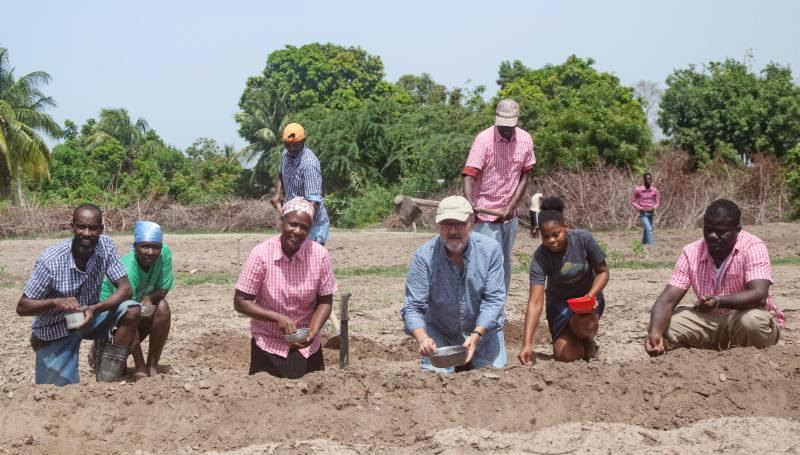Smallholder farmers near Gonaives, Haiti, are in the midst of planting the first commercial cotton crop this country has seen since 1987. Last Thursday, some of these farmers gathered to help plant a demonstration farm where other smallholders will be trained in cultivating a crop that was once Haiti’s fourth largest agricultural export. And in a practical tutorial about export markets, the farmers wore cotton shirts from Timberland, the global outdoor lifestyle brand that is partnering with the Smallholder Farmers Alliance(SFA) to bring this valuable crop back to Haiti. It was explained that shirts like those they were wearing will eventually incorporate the harvest from fields such as this. The reason is that Timberland, Vans and Patagonia–the three companies that have committed to buying organic cotton from Haiti (subject to price and quality)–are putting their support behind smallholders as key to the future of agriculture.
|
Farmers near Gonaives, Haiti, planting cotton seeds are joined by Hugh Locke (middle front) and Timote Georges (right) of the Smallholder Farmers Alliance (SFA). Everyone is wearing Timberland shirts in acknowledgement that these same items will soon begin to incorporate smallholder-grown organic Haitian cotton. Photo: Thomas Noreille / SFA
|
What makes the initiative unique is the SFA model whereby farmers earn the cotton seeds, tools and agricultural training needed to grow the crop by planting trees. The result is that every field of cotton results in up to 50 trees being planted for food, timber, living fences or farmer-led reforestation projects. This “tree currency” model, developed with support from Timberland, also allows farmers to exchange their tree planting credits for services that include acquiring livestock, micro loans for women farmers, basic business training, and participation in local seed banks.
Another unique aspect of this cotton project is that the SFA is designing a new data management system designed to track each export crop, starting with cotton, in order to precisely measure how it impacts smallholder income, women’s empowerment, climate change and food security. In addition to the SFA, Timberland, Vans and Patagonia, the Capstone Project at Columbia Universityhas just signed on for a second year of graduate student engagement to help design this new data system.
 |
|
| Preparing the cotton field for planting. |
The food security reference above bears further comment. No farmer in the SFA program can grow cotton on more than half their land. And the tree credits they earn apply not only to their cotton crop, but also the rest of their farm. Given that farmers new to the SFA see yields going up by a minimum of 40% through a combination of better quality seed, good hand tools and basic agricultural training, this represents a direct offset to the land that is dedicated to cotton.
In all of this the SFA is working hand-in-hand with the Haitian Ministry of Agriculture, for our cotton project, and with the Ministry of Environmentfor our overall tree planting component. And hats off to DHL for stepping in to help the SFA get cotton seed to Haiti in time for planting. Not only did DHL ship 2,500 lbs of cotton seed from Texas, but they also donated the air freight service as a contribution to improving the country’s agricultural outlook.
Two of the farmers planting last Thursday spoke about their experience with cotton:
 |
.
Claudine Jean, age 49, farms 2.5 hectares (5 acres) together with her husband. Last week they planted part of their land in cotton. “My mother grew cotton and I always remember it was a good crop for our family,” she said, “And now I can show my own daughters how to grow it.”
 |
Flaubert Bien-Aimé, age 52, farms 3.5 hectares (7.5 acres) and has planted part of that in cotton. “My parents grew cotton, but the last time was 1985,” he said, “So we are very happy to have it come back to Haiti.”
Regards,
|
|
Hugh Locke
